 She was one of the most watched people in the world—onscreen and off. 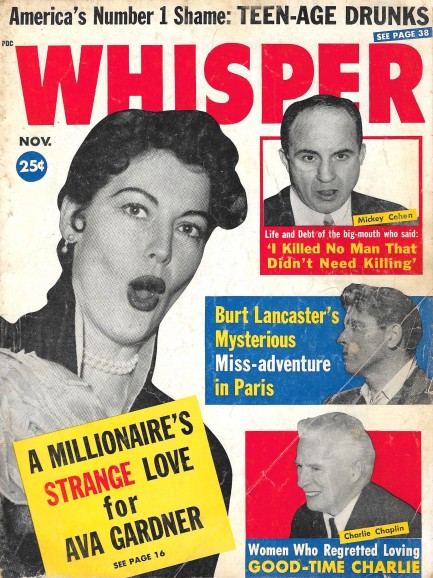
Whisper magazine, in this issue published this month in 1961, offers readers an interesting story about an unnamed millionaire's obsession with Ava Gardner. Apparently the millionaire hired people to follow Gardner around 24/7, all over the world, and report back to him, with this surveillance going on for years. The purpose? If he couldn't have her, he at least wanted to know what she was doing. Whisper focuses on a particular spy named Bill, the fourth of four spies employed by the millionaire, who Gardner came to be friends with and let live on her property, rather than have to sleep in his car night after night. Is this tale true? Maybe. Money buys a lot—including tolerance for bad behavior.
And speaking money, there's also a story on gangster Mickey Cohen, who counted among his consorts Liz Renay and Candy Barr, both of whom we've discussed, Renay here, and Barr here and here. Barr has also shown up in five magazines we've posted. The easiest way to see those is click her keywords and scroll. Cohen proves that no matter what people try to tell you, money is an aphrodisiac, because there's no way trolls like him could score beautiful dancers and models if it weren't for wealth. Take a look at the worst man in the world, and if he has money, he has a wife far more beautiful than makes sense.
Whisper goes on to talk about Burt Lancaster's and Charlie Chaplin's lovers, teen-age drunks, Soviet honeytraps, U.S. prisons, Jane Fonda's professional and family lives, and more. It was a Robert Harrison publication that morphed from a cheesecake magazine with painted pin-up covers into a gossip rag. That happened around 1954, when the original Whisper, launched in 1946, began going broke thanks to an inability to compete with girly magazine numero uno—Playboy. But there was plenty of room in the tabloid market and Harrison made Whisper a staple monthly on par with Confidential, his flagship publication. We'll have more from Whisper later, as always. 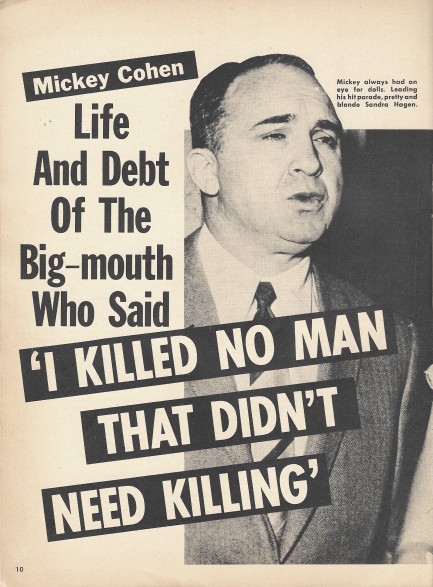 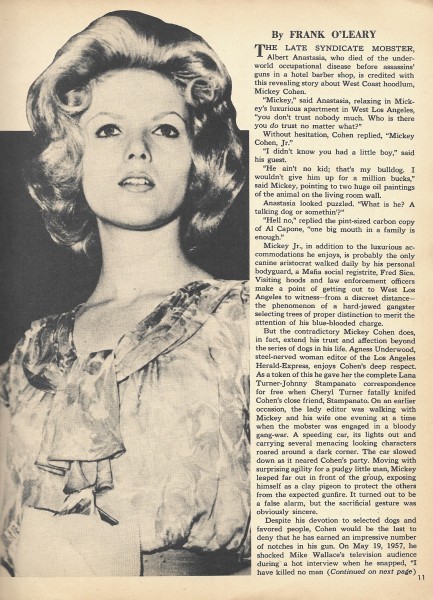 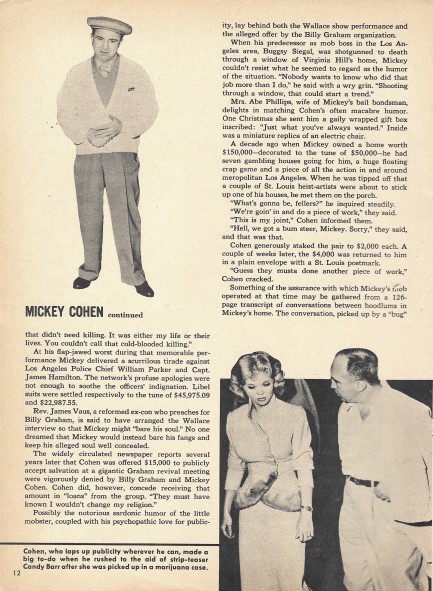 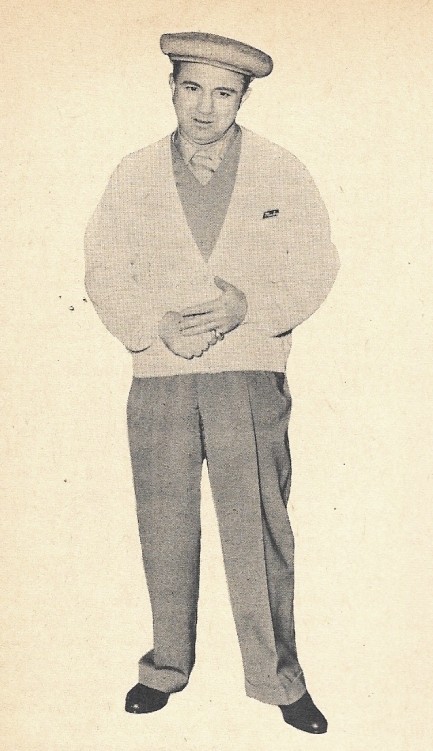 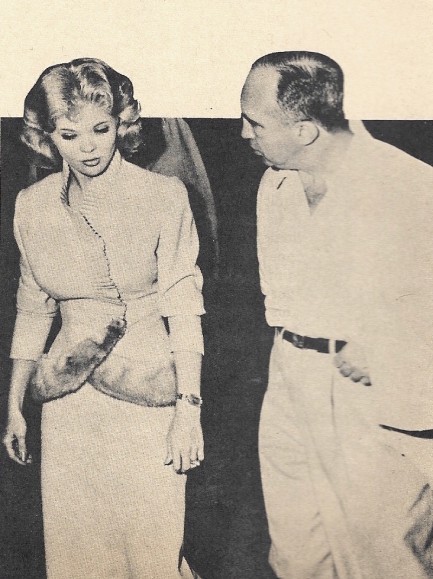 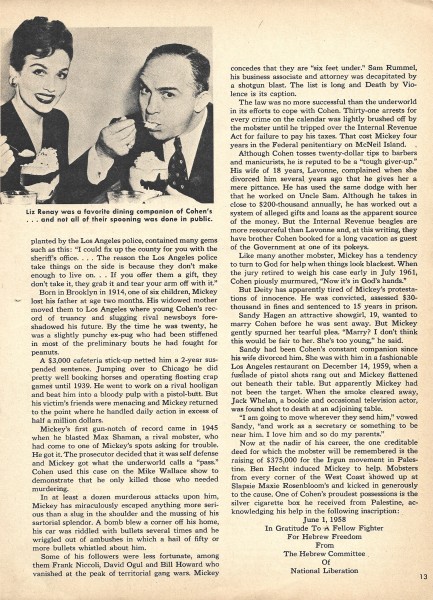 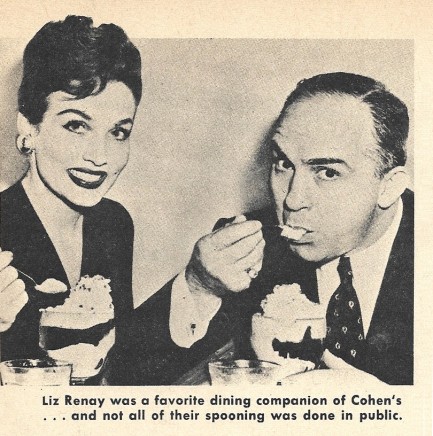 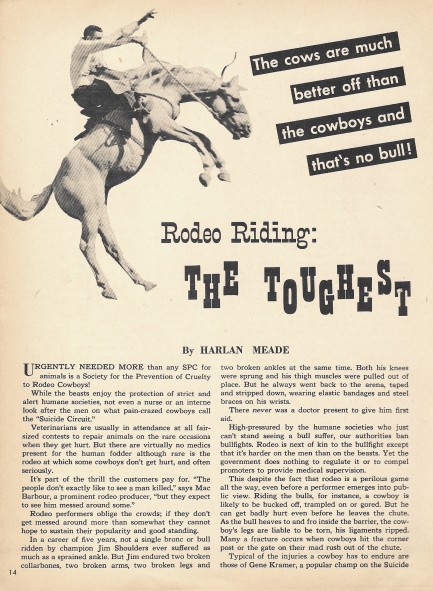 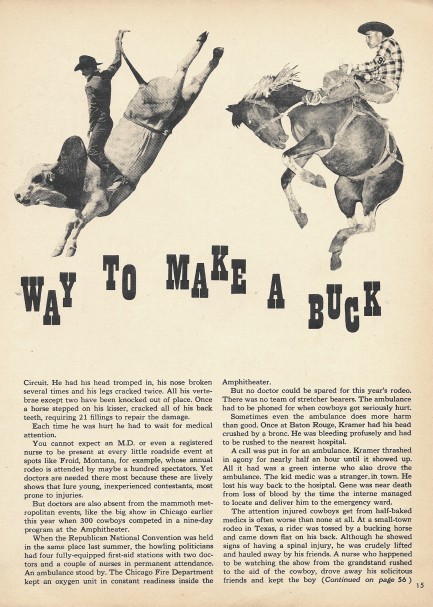 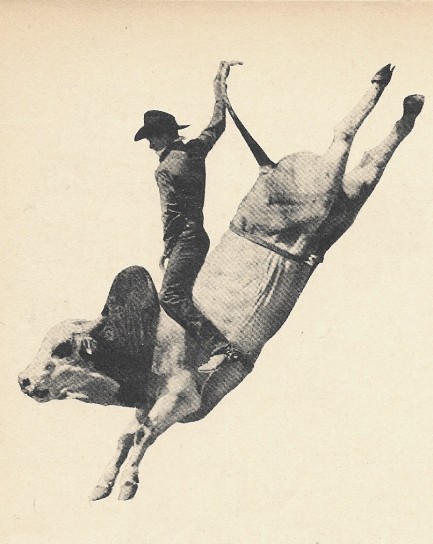 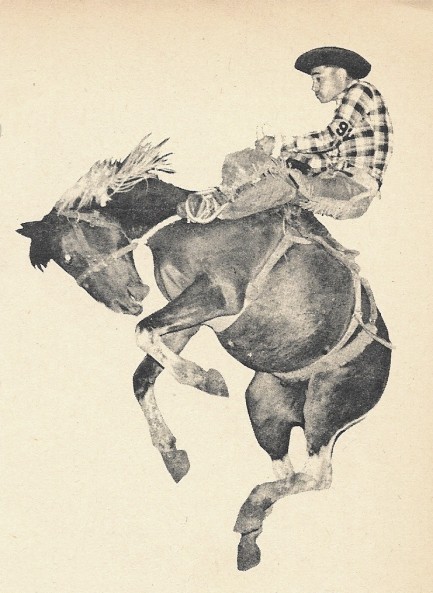 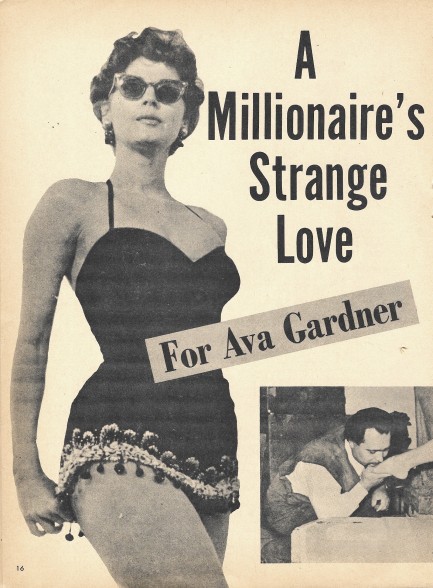 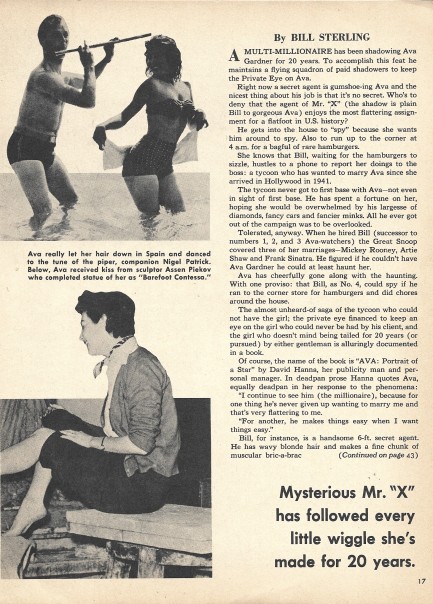 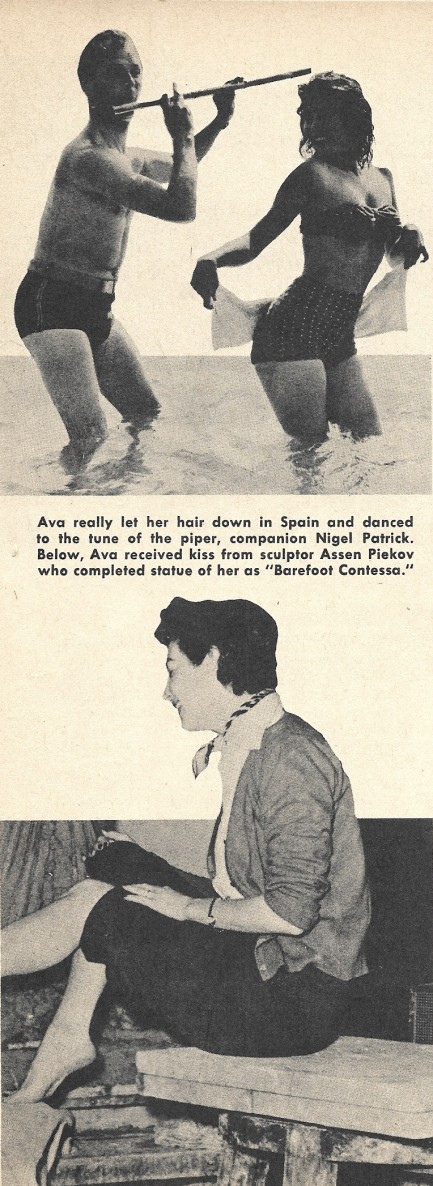 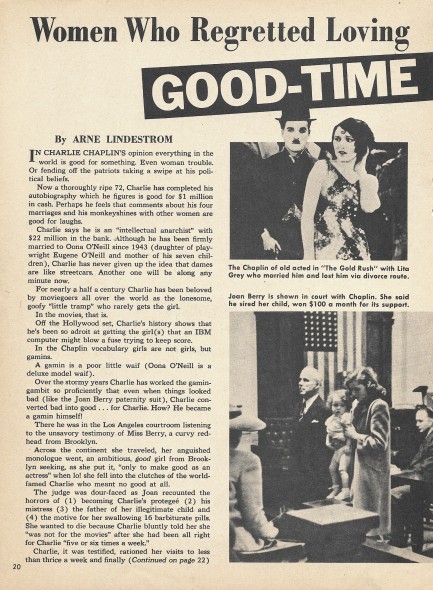 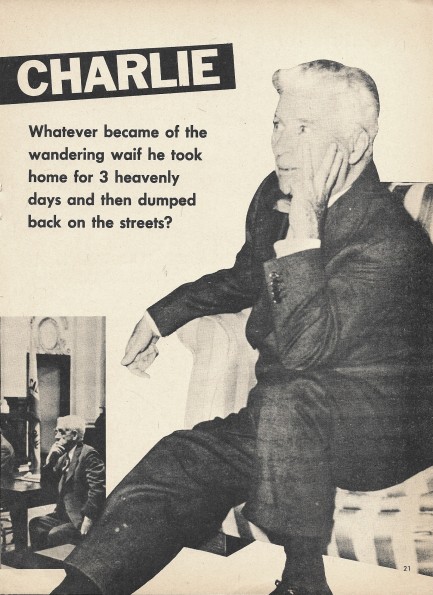 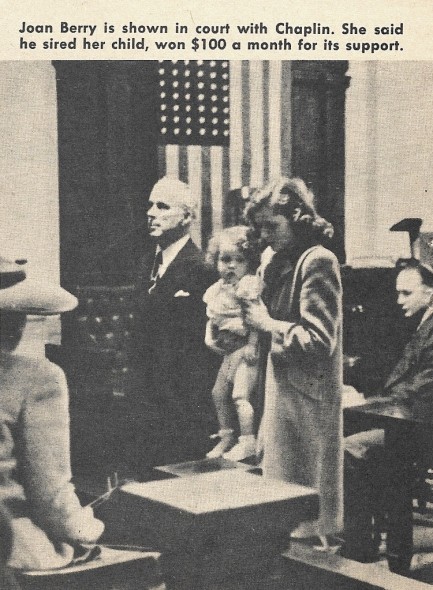 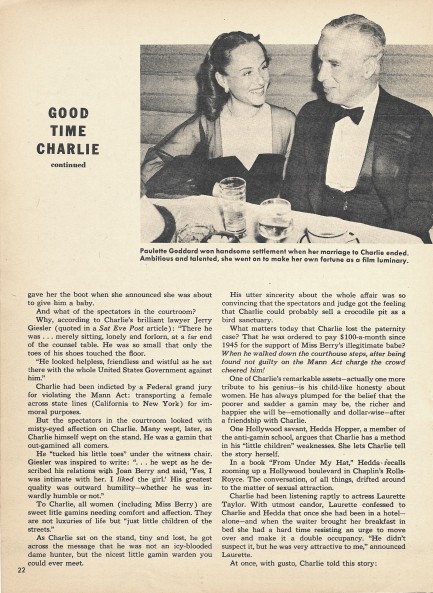 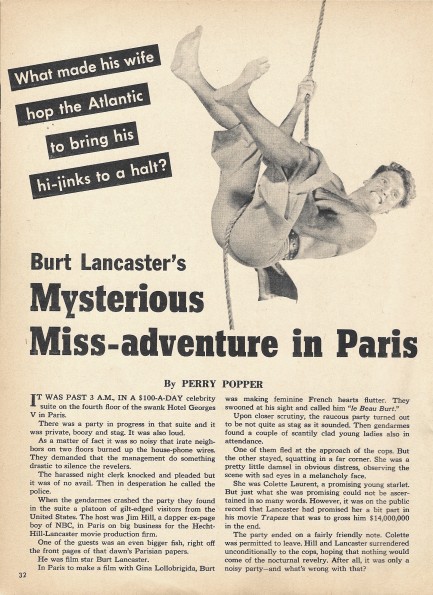 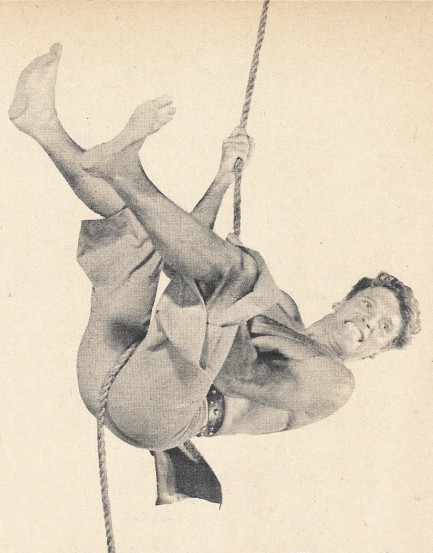 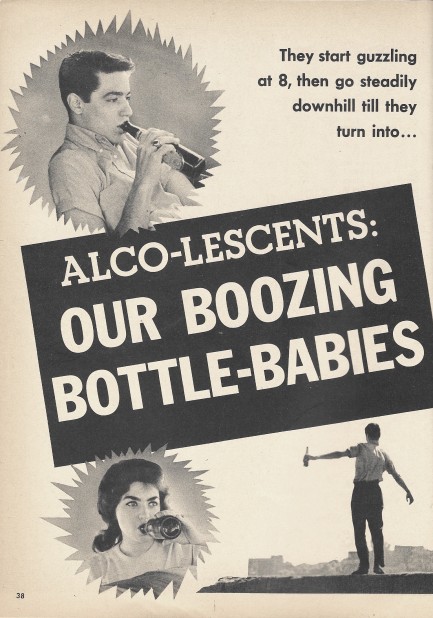 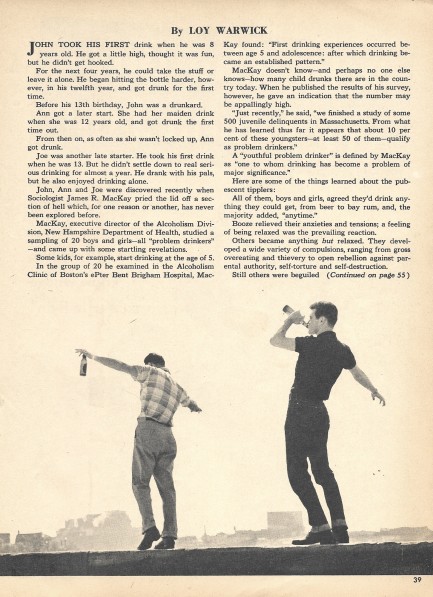 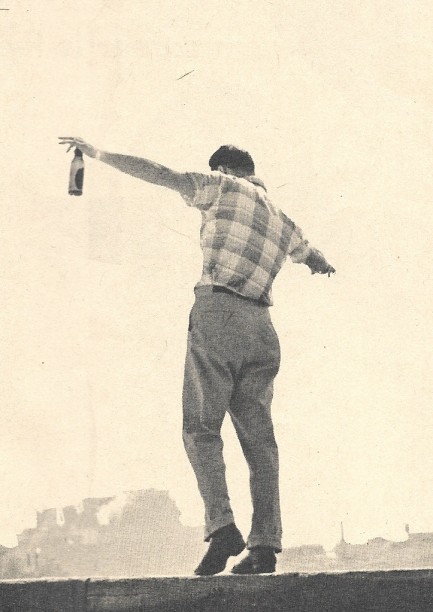 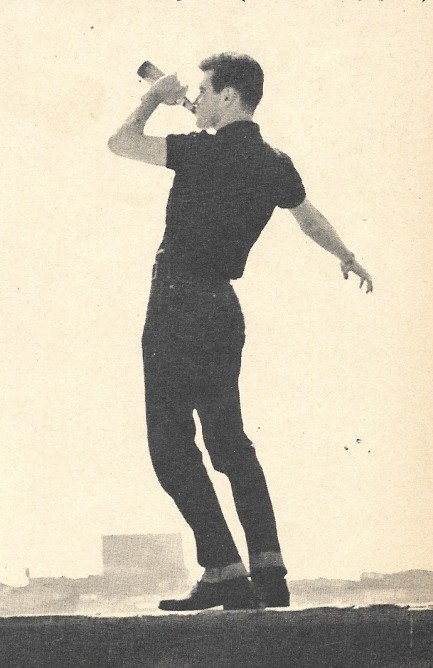 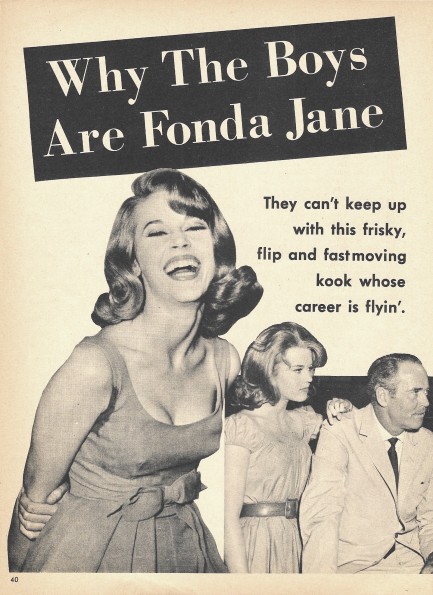 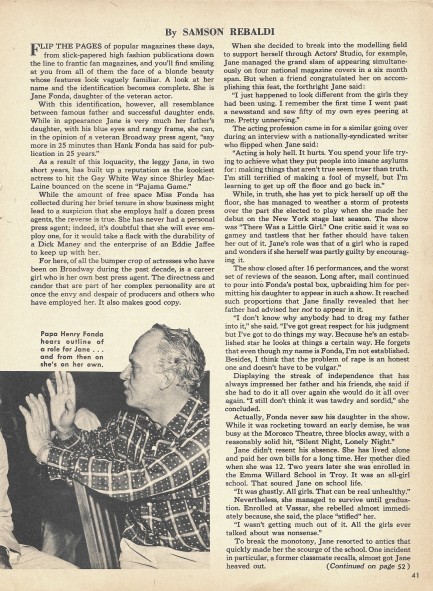
 Extra, extra, read all about it! 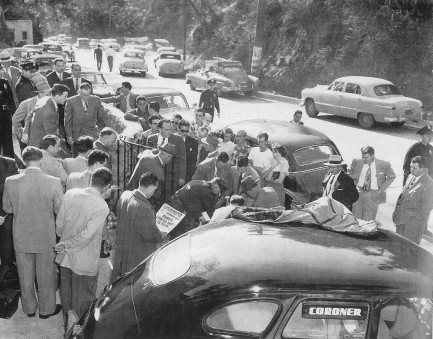
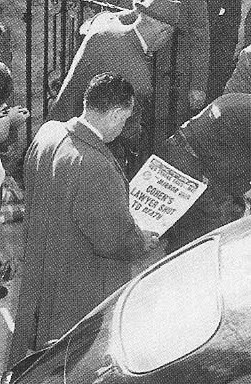 The above photo shows the murder scene of Los Angeles mob lawyer Sam Rummell who was messily dispatched in front of his Laurel Canyon villa via shotgun blast in 1950. Around 1:30 a.m., as he climbed the steps to the sprawling house, someone or someones with deadly aim blew off the left rear quadrant of his head. Rummell ran with the notorious mobster Mickey Cohen for years, and had been neck deep not only in Cohen's multimillion dollar prostitution and gambling operations, but also in schemes to oust mayor Fletcher Bowron in a recall election, and to take control of the LAPD. The above photo shows the murder scene of Los Angeles mob lawyer Sam Rummell who was messily dispatched in front of his Laurel Canyon villa via shotgun blast in 1950. Around 1:30 a.m., as he climbed the steps to the sprawling house, someone or someones with deadly aim blew off the left rear quadrant of his head. Rummell ran with the notorious mobster Mickey Cohen for years, and had been neck deep not only in Cohen's multimillion dollar prostitution and gambling operations, but also in schemes to oust mayor Fletcher Bowron in a recall election, and to take control of the LAPD.
The insider theory was Rummell was killed to prevent his appearance before a grand jury to testify about an alleged conspiracy between the L.A. County Sheriff's Department and a company called Guarantee Finance, a front for a massive Cohen-controlled bookmaking operation. The insider theory was also that L.A. Sheriff's officers pulled the trigger. These remained mere theories, because the killer or killers were never caught. All very interesting, one more dead mob underling, but that isn't why we shared the photo. A close look reveals, at center, a man holding an edition of the Los Angeles Mirror with a headline reading: Cohen's Lawyer Shot To Death. Yes, Mirror staff were so quick with their Extra edition that it hit newsstands before Rummell's murder scene had been cleared. That's journalism—late night, coffee-fueled, time-pressured, editor-with-a-whip journalism. And the photo is an fascinating example of it working perfectly, sixty-six years ago today. 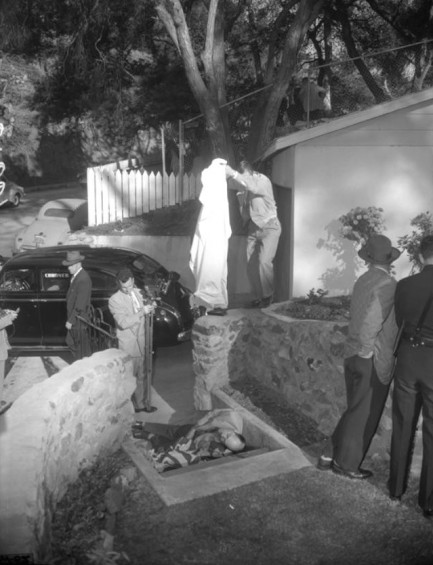
 She had nothing to hide on stage, but she certainly did elsewhere in her life. 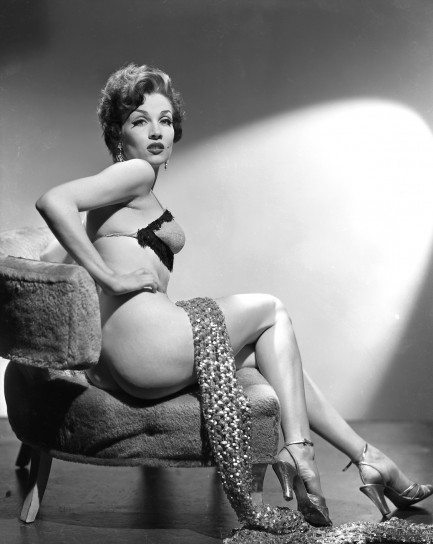 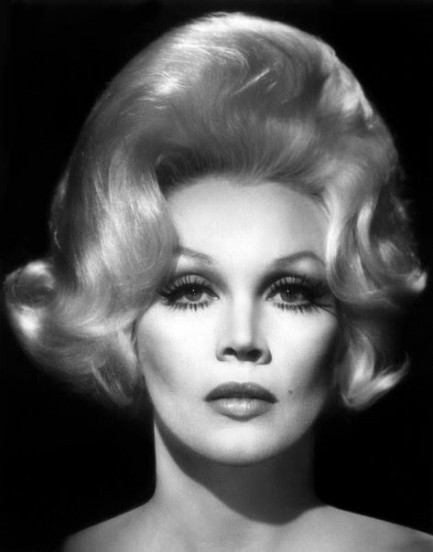
Liz Renay’s Washington Post obituary called her a “Cult Actress, Stripper and Mobster’s Girl.” That only touches on what she was. She was also an author, painter, streaker, charm school instructor, and convict. The latter designation came when a federal judge sent her up for perjury committed during the gangster Mickey Cohen’s 1961 tax evasion trial. Cohen was Renay’s boyfriend, and her bad taste and unshakable loyalty cost her more than two years on Terminal Island, years she says permanently damaged her prospects in Hollywood. After her release she became a professional celebrity, more famous for her associations and striking blonde appearance than anything she did, with her cult status reaffirmed by such people John Waters, who put her in his film Desperate Living, and author James Ellroy, who included her in his explosive 1995 novel American Tabloid. The sultry shot of Renay at top, pre-blonde, pre-Cohen, and pre-prison, dates from the mid-1950s. The second is from around 1960, and the one below shows her in 1961 entering the courtroom during Cohen’s trial. 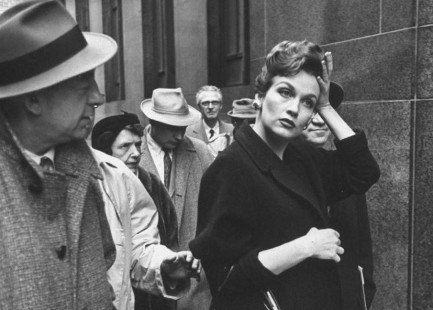
 Everybody wanted a piece of Candy. 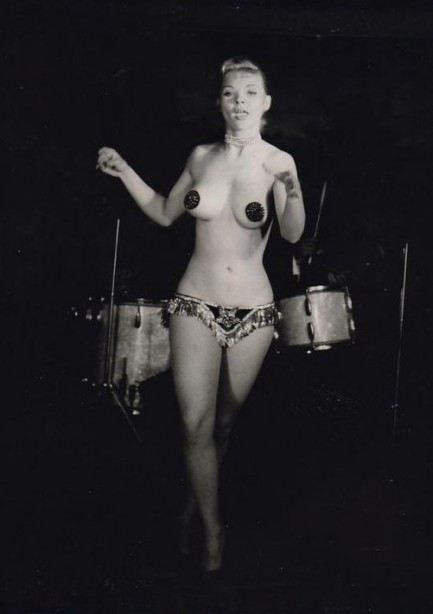
She was born Juanita Dale Slusher, but danced under the much more palatable name Candy Barr. This shot dates from the mid-1950s, when she was beginning to enjoy success on the nationwide dance circuit after a dubious beginning as a teen hooker and star of a porno film at age sixteen. Along with recognition on the dance circuit came trouble, and she would have numerous legal run-ins, including drug charges, an arrest for shooting her abusive husband, and time as a fugitive in Mexico. She was involved with West Coast mobster Mickey Cohen, and became friends with Texas gangster wannabe Jack Ruby. Barr really deserves a more detailed treatment, considering how quintessentially pulp her life was, so we’ll try to get back to her very interesting story a bit later.
 What do you get for being a member of the Mickey louse club? A cap... in your ass. 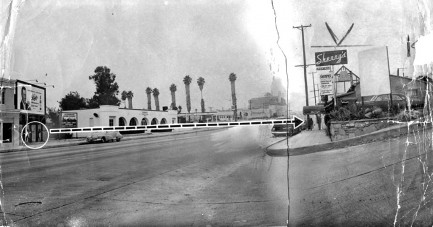 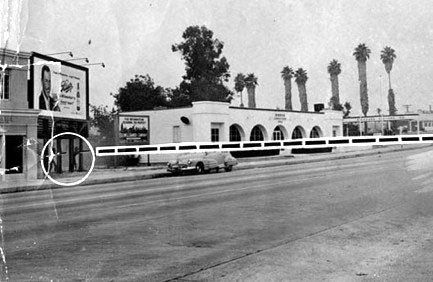
Tonight in 1949 just before 4 a.m.—i.e. early in the morning of July 20—L.A. mobster Mickey Cohen was ambushed by unknown gunmen outside a Sunset Boulevard eatery called Sherry’s. The above photo diagram and close-up shows where his assailants hid behind a billboard across the street from the restaurant and opened fire with shotguns. Cohen was hit in the shoulder, three others were seriously wounded, and New York Daily News reporter Florabel Muir was bruised by a ricochet (or shot directly, according to some accounts). The photo just below shows the view the gunmen had from underneath the billboard. And the last two show the immediate aftermath of the shooting, with a surprising number of bystanders and/or restaurant patrons present considering the late hour, and Cohen henchman Edward Herbert on the ground. He would later die from his wounds. The Sherry’s ambush was the second of several attempts on Cohen’s life. None were successful, though as usual, the members of his circle did not fare well. For a look at a cool collection of photo diagrams and an explanation of their use, see here. 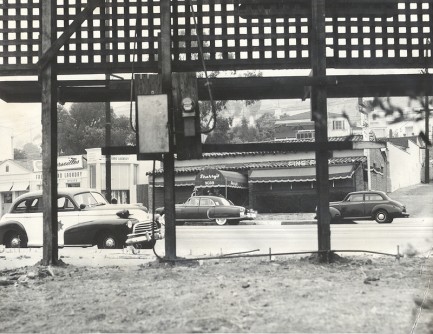 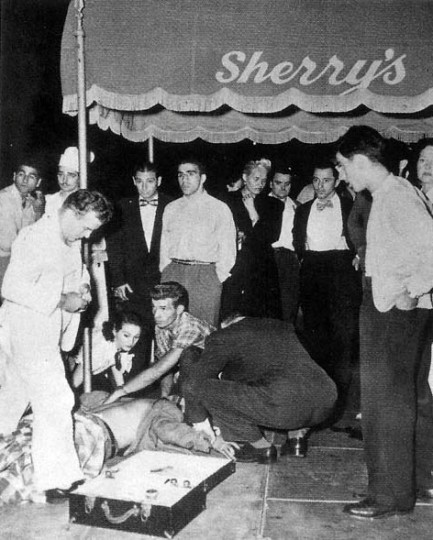 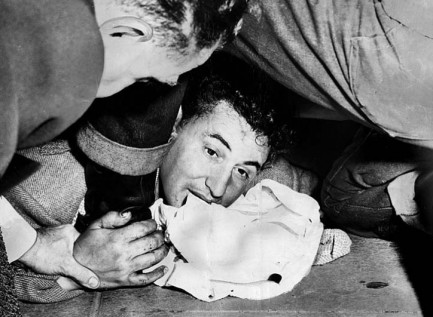
 Photo diagrams were used as law enforcement and legal tools, but are almost an art form in themselves.
Researching the Hazel Glab case exposed us, as we mentioned in that post, to newspaper illustrations, which in turn led us to some crime scene photo diagrams. These images were used by police, lawyers and jurors to understand the geography of crime scenes and the physics of the events. We were fascinated by the images, and when an online forum pointed us toward the Los Angeles Public Library’s online collection, we headed over there and dug into the archive. We’ve shared our finds below, with details about each crime.
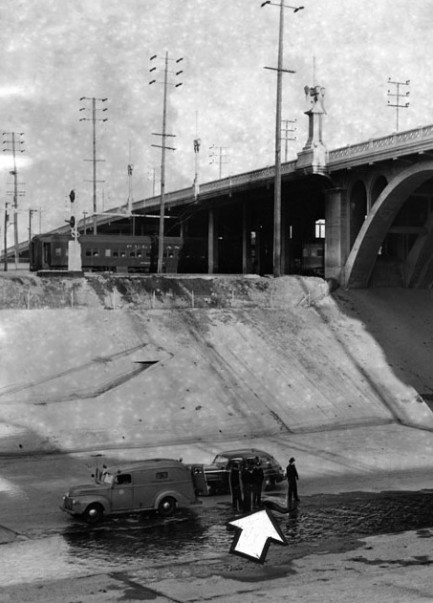 Body found in L.A. River, 1949. Body found in L.A. River, 1949.
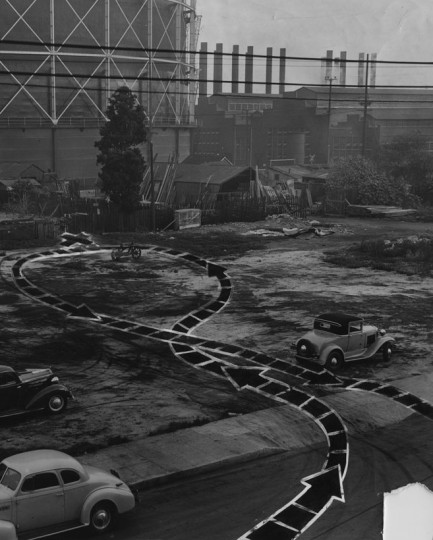 Girl found stabbed to death 26 December, 1936, at 721 Turner Street, with an X marking the location of her body and arrows marking the direction a car arrived and departed. Girl found stabbed to death 26 December, 1936, at 721 Turner Street, with an X marking the location of her body and arrows marking the direction a car arrived and departed.
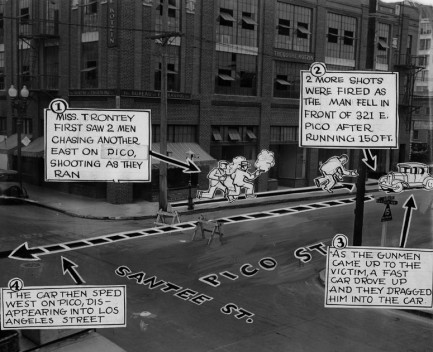 Armed robbery, 11 August, 1930, on East Pico in Los Angeles. Armed robbery, 11 August, 1930, on East Pico in Los Angeles.
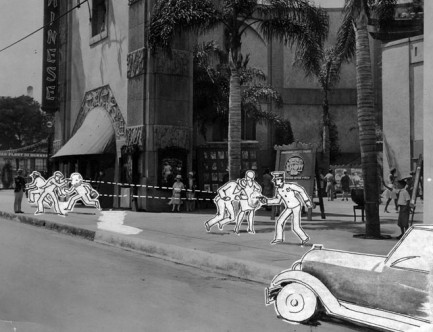 Armed robbery at Grauman’s Chinese Theater, with $15,000 stolen and a police officer wounded, 16 July, 1929. Armed robbery at Grauman’s Chinese Theater, with $15,000 stolen and a police officer wounded, 16 July, 1929.
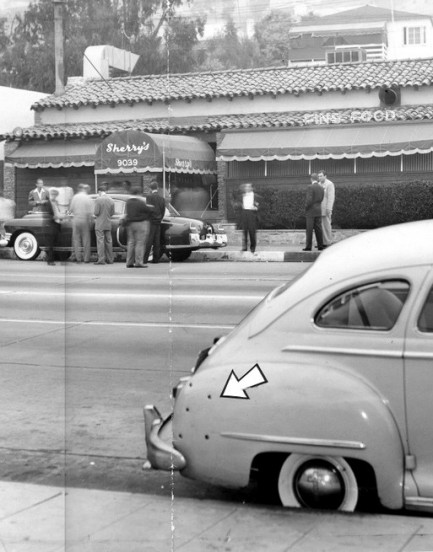
This shows the crime scene after the attempted killing of gangster Mickey Cohen, with bullet holes in a parked car across the street from where Cohen was standing, 20 July, 1949. 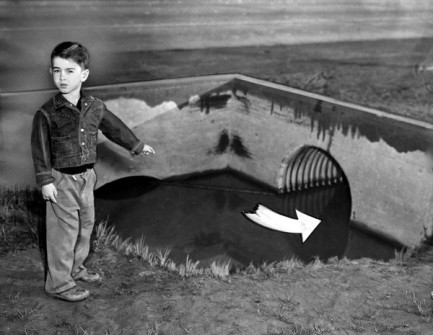 Photo of a boy pointing to where his friend was sucked into a storm drain. The friend drowned, 1953. Photo of a boy pointing to where his friend was sucked into a storm drain. The friend drowned, 1953.
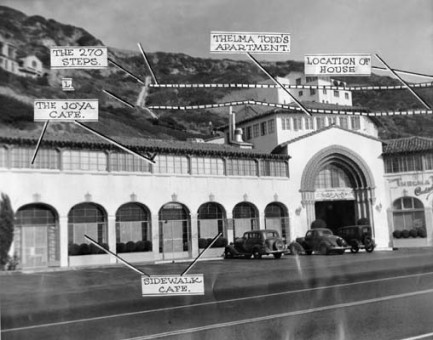 1936 photo diagram showing the last movements of actress Thelma Todd, who was found dead in her car in December 1935. 1936 photo diagram showing the last movements of actress Thelma Todd, who was found dead in her car in December 1935.
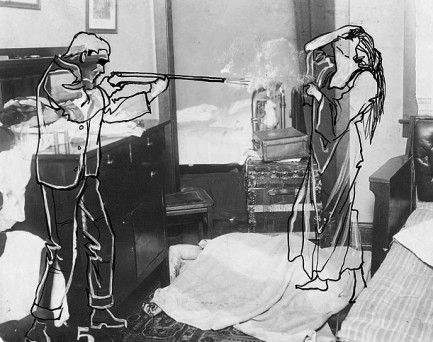 Unknown and undated crime scene photo with drawing of presumed positions of assailant and victim. Unknown and undated crime scene photo with drawing of presumed positions of assailant and victim.
 She’s a real beaut—powerful, roomy, and gets two gallons to the mile. 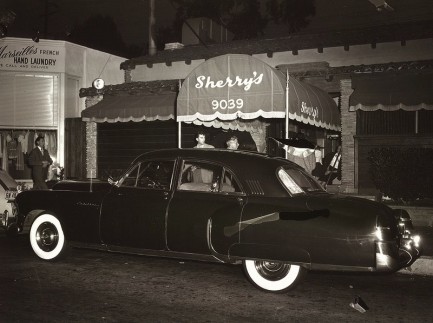
More from the USC digital photo archive. It looks like just another black Cadillac, but no, this one belonged to mobster par excellence Mickey Cohen and it’s parked outside the L.A. eatery Sherry’s, where he was the target of an assassination attempt in July 1949. Gunmen shot Cohen in the shoulder (or arm, depending on the telling), fatally wounded one of his friends, seriously wounded two others, and managed to hit journalist Florabel Muir in the ass with a non-penetrating ricochet. Having learned a lesson, Cohen had his next Cadillac bulletproofed (bombproofed as well, by some accounts). Below are a couple of photos of that car and the two-inch-thick glass that was installed (all well and good to be sealed inside an armored hotbox, but what if your driver ate broccoli with dinner?). Anyway, Cohen sold the Caddy in 1951 for $12,000, supposedly because it wasn’t street legal. He died of natural causes in 1976. 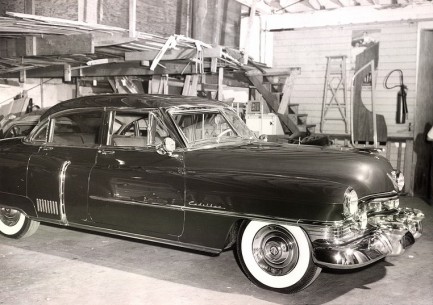 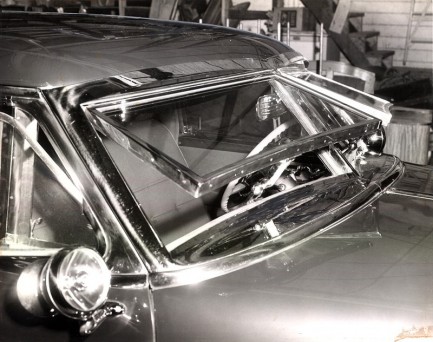 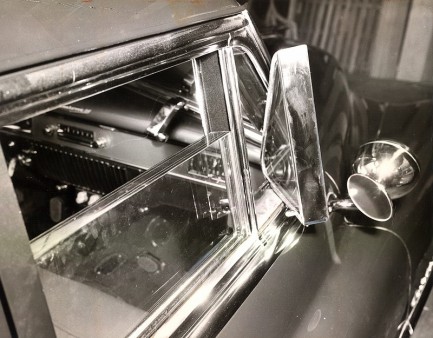
|
 |

The headlines that mattered yesteryear.
2003—Hope Dies
Film legend Bob Hope dies of pneumonia two months after celebrating his 100th birthday. 1945—Churchill Given the Sack
In spite of admiring Winston Churchill as a great wartime leader, Britons elect
Clement Attlee the nation's new prime minister in a sweeping victory for the Labour Party over the Conservatives. 1952—Evita Peron Dies
Eva Duarte de Peron, aka Evita, wife of the president of the Argentine Republic, dies from cancer at age 33. Evita had brought the working classes into a position of political power never witnessed before, but was hated by the nation's powerful military class. She is lain to rest in Milan, Italy in a secret grave under a nun's name, but is eventually returned to Argentina for reburial beside her husband in 1974. 1943—Mussolini Calls It Quits
Italian dictator Benito Mussolini steps down as head of the armed forces and the government. It soon becomes clear that Il Duce did not relinquish power voluntarily, but was forced to resign after former Fascist colleagues turned against him. He is later installed by Germany as leader of the Italian Social Republic in the north of the country, but is killed by partisans in 1945.
|

|
|

It's easy. We have an uploader that makes it a snap. Use it to submit your art, text, header, and subhead. Your post can be funny, serious, or anything in between, as long as it's vintage pulp. You'll get a byline and experience the fleeting pride of free authorship. We'll edit your post for typos, but the rest is up to you. Click here to give us your best shot.

|
|






























 The above photo shows the murder scene of Los Angeles mob lawyer Sam Rummell who was messily dispatched in front of his Laurel Canyon villa via shotgun blast in 1950. Around 1:30 a.m., as he climbed the steps to the sprawling house, someone or someones with deadly aim blew off the left rear quadrant of his head. Rummell ran with the notorious mobster Mickey Cohen for years, and had been neck deep not only in Cohen's multimillion dollar prostitution and gambling operations, but also in schemes to oust mayor Fletcher Bowron in a recall election, and to take control of the LAPD.
The above photo shows the murder scene of Los Angeles mob lawyer Sam Rummell who was messily dispatched in front of his Laurel Canyon villa via shotgun blast in 1950. Around 1:30 a.m., as he climbed the steps to the sprawling house, someone or someones with deadly aim blew off the left rear quadrant of his head. Rummell ran with the notorious mobster Mickey Cohen for years, and had been neck deep not only in Cohen's multimillion dollar prostitution and gambling operations, but also in schemes to oust mayor Fletcher Bowron in a recall election, and to take control of the LAPD. 













 Body found in L.A. River, 1949.
Body found in L.A. River, 1949. Girl found stabbed to death 26 December, 1936, at 721 Turner Street, with an X marking the location of her body and arrows marking the direction a car arrived and departed.
Girl found stabbed to death 26 December, 1936, at 721 Turner Street, with an X marking the location of her body and arrows marking the direction a car arrived and departed. Armed robbery, 11 August, 1930, on East Pico in Los Angeles.
Armed robbery, 11 August, 1930, on East Pico in Los Angeles. Armed robbery at Grauman’s Chinese Theater, with $15,000 stolen and a police officer wounded, 16 July, 1929.
Armed robbery at Grauman’s Chinese Theater, with $15,000 stolen and a police officer wounded, 16 July, 1929.
 Photo of a boy pointing to where his friend was sucked into a storm drain. The friend drowned, 1953.
Photo of a boy pointing to where his friend was sucked into a storm drain. The friend drowned, 1953. 1936 photo diagram showing the last movements of actress Thelma Todd, who was found dead in her car in December 1935.
1936 photo diagram showing the last movements of actress Thelma Todd, who was found dead in her car in December 1935. Unknown and undated crime scene photo with drawing of presumed positions of assailant and victim.
Unknown and undated crime scene photo with drawing of presumed positions of assailant and victim. 








































































